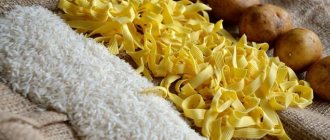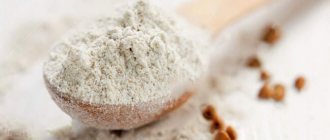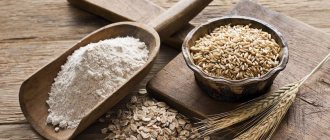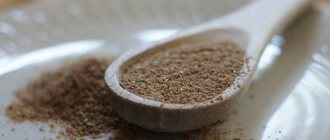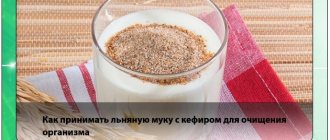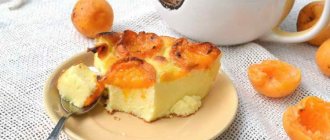Almond flour is considered a unique, very healthy and widely used ingredient in the air conditioner arsenal in many countries around the world.
This is an indispensable component in the recipe of delicious desserts, cakes, pastries, creams, meat dishes and fruit salads. Various salads and stews, as well as first courses, acquire a pleasant taste of nuts and a rich concentration.
Almond flour
- Potassium 659 mg
- Calcium 236 mg
- Magnesium 268 mg
- Sodium 19 mg
Almonds are highly valued all over the world. It is consumed in its pure form as a snack, added to baked goods, salads, and butter and flour are also obtained from it. The benefits of almonds have been praised many times, but what about the flour obtained from them? Fortunately, this product retains almost all the beneficial qualities of the nut. The main advantage of almond flour is the absence of gluten. Therefore, it is good to use for those who are allergic to gluten or follow a diet for other medical reasons. Almond flour has replaced wheat flour for many. And no wonder.
What can you make with almond flour?
On a ketogenic diet, cooking your own food allows you to accurately calculate the ratio of proteins, fats and carbohydrates in your diet. But when replacing regular wheat or other gluten-rich flour with almond flour, you should be prepared for some surprises.
Among the features of working with this product are:
- increased humidity of the mass;
- friability of baked products;
- presence of a characteristic nutty taste;
- high calorie content of ready meals;
- smaller baking volumes.
The applications of almond flour are varied. When replacing wheat flour with almond flour in recipes, the volumes of the product remain identical. But baked goods rise worse. Due to the lack of gluten in the composition, it is necessary to use other binders.
The main purpose of almond flour is baking. Pancakes, bread, pies, muffins, pizza, tartlet base or porridge. Here is just a small part of the products that can be created based on this product. Also, coarse almond flour can be a good breading for fish and meat.
Popular recipes based on this product include frangipane, macaroons, and cakes. Almond flour works well in salad dressings, sauces, and cream soups.
Where is it used?
Used in many industries. Added to bread, pasta, cookies, breakfast cereals, sausages and processed foods.
Adding it to various baked goods allows you to maintain the volume of the product and make it more tender. At the same time, the dough becomes plastic and easier to roll out. Bakery and confectionery products with the addition of powder do not go stale longer. During production, they do not absorb a lot of fat (for example, donuts, crumpets).
When baking, it can easily replace eggs . Instead of one egg, take a tablespoon of flour diluted in a tablespoon of water. Used as a thickener for various sauces. Addition to various products enriches them with vitamins and increases nutritional value. Reduces its cost.
Soy is added not only to bread and confectionery products. It is also found in vegetable purees, canned fish and meat. Soy is added in small quantities, only from one to five percent.
Soy protein is also used in cosmetology. Skin and hair care products are made on its basis. Soy cosmetics smooth out wrinkles and moisturize the skin.
Application
Flour based on almond seeds has a large amount of vitamins and useful elements in its composition. These include: vitamin E, vitamin B, amino acids, zinc, iron, phosphorus, antioxidants. It is thanks to this rich composition that this product can be used not only for baking desserts, but also for medicinal purposes.
Almond flour in cooking
The main application of flour is cooking. It is the main component in the preparation of sweets such as macaroons, marzipan, frangipane. If you add almond powder to a biscuit dough recipe, the cake itself will turn out softer and fluffier, and due to the low amount of harmful carbohydrates, even a person who is losing weight can afford such a biscuit. In addition, this component is added to recipes for preparing butter creams for cakes. It is sometimes added to salad dressings, sauces and casseroles.
Almond flour for medicinal purposes
This variety can be used to prepare various masks for both the face and hair. For example, one of the simplest and fastest face masks to prepare: pour a tablespoon of flour with a small amount of warm water and stir until a homogeneous thick consistency.
Did you know? The world's largest cake was baked in Las Vegas for City Day in 2005. Its length was 31 m, and this giant weighed 58.967 tons.
Apply to face, keep for 5-10 minutes. Such masks will heal damaged areas, making them stronger. Products prepared from this variety will help speed up digestive processes and improve metabolism.
What can be replaced
Almond flour can be replaced with any other type of product. Its only difference is that other varieties contain gluten, but this type does not, which makes it safe for people with individual intolerance. Also, other varieties will have more calories, but are suitable for replacement.
Thus, we can conclude that almond flour is safer for the human body, does not contain harmful substances and is saturated with vitamins. If desired, it can be used for any type of baking, but it will give the dishes a specific taste.
Manufacturing technology for almond flour
When producing almond flour, the factory uses the following technology. First of all, almonds are cleaned of debris and separated into separate fractions. They are then steamed and peeled. At the same time, at the next stage of the production line, quality control of peeling almond nuts is provided. Incompletely peeled nuts are sent for re-cleaning.
After cleaning, the almonds undergo two-stage drying, which removes moisture both from the surface of the nuts and from the inside. Then, using special equipment, the nuts are crushed, crushed and finely ground. Modern equipment allows you to adjust the size of the fraction and achieve grinding up to 40 microns. The resulting powder is distributed into batches and sent to prepared packages.
Recipe for making almond flour at home:
It’s easy to remember how to make almond flour at home. However, flour prepared at home will be somewhat inferior to store-bought flour, because due to the lack of special equipment, you will not be able to replicate the taste and consistency exactly. Store-bought almond flour is better ground, making culinary products made from it lighter and airier. However, finding almond flour is not always easy. The product can be found in specialized stores or on the Internet. Therefore, if for some reason you were unable to purchase store-bought almond powder, you can prepare it at home using almonds.
To make almond flour at home, you don't need a lot of ingredients. The first step is to boil the water. Pour boiling water over well-washed almonds under water. Leave the nuts for 5 minutes. Then drain the water and rinse the almonds again under cold water. Repeat the procedure with boiling water, leaving the nuts again for 5 minutes. Now start peeling the nuts. Transfer the peeled nuts to a clean towel and wait until the towel absorbs moisture. After which they can be transferred to a baking sheet previously covered with baking paper.
Turn on the oven at 100 degrees Celsius. Dry the almonds in the oven for 20 minutes, stirring, turning and checking occasionally. If you want white almond flour, remove the almonds from the oven before they turn golden. Remove the nuts from the heat and let them cool. Transfer some of the nuts to a coffee grinder or blender and grind. Grind the nuts for no longer than 10 seconds, otherwise they will release oil and thicken. If a confectionery recipe uses almond flour and powdered sugar, it is better to grind the nuts together with the powdered sugar, which will simplify further preparation of the dish. Sift the resulting mixture through a sieve. The remaining large particles of almonds can be ground again in a coffee grinder. This is how you can easily make your own almond flour at home. It can be used to prepare a confectionery product according to a recipe. It is better to store almond powder obtained at home in a dry, closed glass jar for no more than 30 days.
Product varieties
The food industry offers only 3 variations of soy flour: low-fat, non-fat, semi-skimmed.
The low-fat product is made from food meal.
Meal is a by-product of oil production. Fat is extracted from seeds/beans using organic solvents. The resulting product is a valuable nutritious food product. Meal is especially valued for its high protein concentration. The component is used both as an additive to the human diet and as a high-protein feed for animals.
To create full-fat flour, peeled, hulled and deodorized beans are used. The semi-skimmed product consists of soybean cake that has been pre-fat separated and pressed.
According to the variety criteria, soy flour is no different from any other. The first and highest grades indicate additional processing of soybeans. This flour contains absolutely no fiber, vitamins or beneficial nutrients. The processing independently adjusts the composition and instead of a valuable food product, we get empty calories. Always choose wholemeal flour to ensure that your meal is not only tasty, but also nutritious.
Energy value and nutrient composition of different types of flour (per 100 grams)
Other types of flour, their calorie content and composition of BZHU are placed in the table below:
| Types of flour | Calorie content | Carbohydrates | Squirrels | Fats |
| Wheat 1st grade | 331 | 67,6 | 10,6 | 1,3 |
| Wheat 2nd grade | 324 | 63,7 | 11,7 | 1,8 |
| Premium wheat | 334 | 68,9 | 10,3 | 1,1 |
| Whole grain wheat | 298 | 55,8 | 11,5 | 2,2 |
| Linen | 270 | 9 | 36 | 10 |
| Rice | 260 | 79 | 7 | 1 |
| Coconut | 466 | 60 | 20 | 16,6 |
| Corn | 330 | 70 ,2 | 7,2 | 1,5 |
| Almond | 602 | 13 | 25 ,8 | 54,5 |
| Cheremukhovaya | 120 | 21 | 7,8 | 0 |
| Spelled | 149 | 24 | 12 | 0,7 |
| Oatmeal | 369 | 64,9 | 13 | 6,8 |
| Amaranth | 298 | 61,7 | 8,9 | 1,7 |
| Pumpkin | 305 | 23 | 33 | 9 |
| Peanut | 590 | 14,5 | 25 | 47 |
| Spelled | 361 | 67,8 | 17 | 2,4 |
| Buckwheat | 367 | 73 ,7 | 13,6 | 1, 2 |
| Sesame | 462 | 32 | 45 | 12 |
Calorie content Soy flour. Chemical composition and nutritional value.
Nutritional value and chemical composition of “Soy flour”.
The table shows the nutritional content (calories, proteins, fats, carbohydrates, vitamins and minerals) per 100 grams of edible portion.
| Nutrient | Quantity | Norm** | % of the norm in 100 g | % of the norm in 100 kcal | 100% normal |
| Calorie content | 274 kcal | 1684 kcal | 16.3% | 5.9% | 615 g |
| Squirrels | 40 g | 76 g | 52.6% | 19.2% | 190 g |
| Fats | 1.5 g | 56 g | 2.7% | 1% | 3733 g |
| Carbohydrates | 23 g | 219 g | 10.5% | 3.8% | 952 g |
| Alimentary fiber | 17.5 g | 20 g | 87.5% | 31.9% | 114 g |
| Water | 7.25 g | 2273 g | 0.3% | 0.1% | 31352 g |
| Ash | 6.15 g | ~ | |||
| Vitamins | |||||
| Vitamin A, RE | 2 mcg | 900 mcg | 0.2% | 0.1% | 45000 g |
| beta carotene | 0.024 mg | 5 mg | 0.5% | 0.2% | 20833 g |
| Vitamin B1, thiamine | 0.698 mg | 1.5 mg | 46.5% | 17% | 215 g |
| Vitamin B2, riboflavin | 0.253 mg | 1.8 mg | 14.1% | 5.1% | 711 g |
| Vitamin B4, choline | 11.3 mg | 500 mg | 2.3% | 0.8% | 4425 g |
| Vitamin B5, pantothenic | 1.995 mg | 5 mg | 39.9% | 14.6% | 251 g |
| Vitamin B6, pyridoxine | 0.574 mg | 2 mg | 28.7% | 10.5% | 348 g |
| Vitamin B9, folates | 305 mcg | 400 mcg | 76.3% | 27.8% | 131 g |
| Vitamin E, alpha tocopherol, TE | 0.12 mg | 15 mg | 0.8% | 0.3% | 12500 g |
| Vitamin K, phylloquinone | 4.1 mcg | 120 mcg | 3.4% | 1.2% | 2927 g |
| Vitamin RR, NE | 2.612 mg | 20 mg | 13.1% | 4.8% | 766 g |
| Macronutrients | |||||
| Potassium, K | 2384 mg | 2500 mg | 95.4% | 34.8% | 105 g |
| Calcium, Ca | 241 mg | 1000 mg | 24.1% | 8.8% | 415 g |
| Magnesium, Mg | 290 mg | 400 mg | 72.5% | 26.5% | 138 g |
| Sodium, Na | 20 mg | 1300 mg | 1.5% | 0.5% | 6500 g |
| Phosphorus, Ph | 674 mg | 800 mg | 84.3% | 30.8% | 119 g |
| Microelements | |||||
| Iron, Fe | 9.24 mg | 18 mg | 51.3% | 18.7% | 195 g |
| Manganese, Mn | 3.018 mg | 2 mg | 150.9% | 55.1% | 66 g |
| Copper, Cu | 4065 mcg | 1000 mcg | 406.5% | 148.4% | 25 g |
| Selenium, Se | 1.7 mcg | 55 mcg | 3.1% | 1.1% | 3235 g |
| Zinc, Zn | 2.46 mg | 12 mg | 20.5% | 7.5% | 488 g |
| Digestible carbohydrates | |||||
| Mono- and disaccharides (sugars) | 16.42 g | max 100 g | |||
| Essential amino acids | |||||
| Arginine* | 3.647 g | ~ | |||
| Valin | 2.346 g | ~ | |||
| Histidine* | 1.268 g | ~ | |||
| Isoleucine | 2.281 g | ~ | |||
| Leucine | 3.828 g | ~ | |||
| Lysine | 3.129 g | ~ | |||
| Methionine | 0.634 g | ~ | |||
| Threonine | 2.042 g | ~ | |||
| Tryptophan | 0.683 g | ~ | |||
| Phenylalanine | 2.453 g | ~ | |||
| Nonessential amino acids | |||||
| Alanin | 2.215 g | ~ | |||
| Aspartic acid | 5.911 g | ~ | |||
| Glycine | 2.174 g | ~ | |||
| Glutamic acid | 9.106 g | ~ | |||
| Proline | 2.75 g | ~ | |||
| Serin | 2.725 g | ~ | |||
| Tyrosine | 1.778 g | ~ | |||
| Cysteine | 0.757 g | ~ | |||
| Saturated fatty acids | |||||
| Saturated fatty acids | 0.136 g | max 18.7 g | |||
| 14:0 Miristinovaya | 0.003 g | ~ | |||
| 16:0 Palmitinaya | 0.1 g | ~ | |||
| 18:0 Stearic | 0.034 g | ~ | |||
| Monounsaturated fatty acids | 0.208 g | min 16.8 g | 1.2% | 0.4% | |
| 16:1 Palmitoleic | 0.003 g | ~ | |||
| 18:1 Oleic (omega-9) | 0.206 g | ~ | |||
| Polyunsaturated fatty acids | 0.533 g | from 11.2 to 20.6 g | 4.8% | 1.8% | |
| 18:2 Linolevaya | 0.47 g | ~ | |||
| 18:3 Linolenic | 0.063 g | ~ | |||
| Omega-3 fatty acids | 0.063 g | from 0.9 to 3.7 g | 7% | 2.6% | |
| Omega-6 fatty acids | 0.47 g | from 4.7 to 16.8 g | 10% | 3.6% |
The energy value of soy flour is 274 kcal.
Primary Source: Created in the application by the user. Read more.
** This table shows the average levels of vitamins and minerals for an adult. If you want to know the norms taking into account your gender, age and other factors, then use the “My Healthy Diet” application.
BJU, calorie content and composition
Almond flour comes in normal and low fat content. This factor may affect its nutritional value. For a classic product, the indicators will be as follows:
| Calorie content per 100 g | Squirrels | Fats | Carbohydrates |
| 614-631 kcal | 25 g | 52.5 g | 6.6 g |
Almond flour contains up to 7 g of fiber per 100 g of product. It also contains vitamins A, B1, B2, B4, B6, B5, B9, C, E, PP, niacin and beta carotene. Macroelements include phosphorus, potassium, calcium, magnesium and sodium. The composition of the product is also rich in microelements. The product is rich in iodine, manganese, iron, selenium, zinc, fluorine and copper. The predominant acids are linoleic, oleic, omega-6 and omega-3.
| Micronutrients | (mg/100g) | Macronutrients | (g/100g) |
| Potassium | 733 | Squirrels | 23.3 |
| Magnesium | 270 | Fats | 50 |
| Calcium | 269 | – saturated | 3.8 |
| Copper | 1031 | – polyunsaturated | 12.3 |
| Manganese | 2.179 | – monounsaturated | 31.5 |
| Vitamin B1 | 0.205 | Digestible carbohydrates | 5 |
| Vitamin B2 | 1.138 | Indigestible dietary fiber | 11.7 |
| Vitamin E | 25.63 |
How and why to drink apple cider vinegar on a keto diet Why you need Bronecoffee for keto + 13 recipes 100+ KETO products: what you can and cannot eat Keto broths: TOP 6 recipes
Benefits of almond flour
Almond flour retains all the beneficial qualities of almonds, which makes it incredibly healthy. Almond flour is most useful because it contains large quantities of vitamin E, which is an antioxidant. It not only cleanses the body of toxic substances, but also prolongs the life of cells and the body, and also reduces the risk of developing various diseases.
Eating almond flour improves the condition of the nervous system and relieves tension. This effect is provided by vitamin B contained in almonds. The minerals found in almond flour normalize the functioning of the heart, kidneys and liver. Thanks to a large number of useful vitamins and macro- and microelements, almond powder improves human immunity, protecting it from viruses and bacteria.
Diet cookies
Recipes for dietary baking made from soy flour include not only pancakes. If you need a composition that contains more protein and less carbohydrates, then you should perform the following variation.
Ingredients:
- 100 g soy flour;
- 2 times more apples;
- 2 squirrels;
- 20 g oatmeal;
- 10 ml olive oil;
- a little sweetener and soda.
Sequencing:
- The fruits are cleaned, de-seeded and grated.
- The grated mass is mixed with proteins and a sugar substitute;
- After adding the oil, add flour, ground flakes and soda.
- A homogeneous dough is kneaded, from which flat cakes are formed.
- The products are laid out on a baking sheet, which is placed in a hot oven (180 °C) for 25 minutes.
Before placing the mold in the oven, the products are pierced with a fork.
Harm of almond flour
There can be no direct harm from almond flour. However, if consumed excessively, flour can cause stagnation in the gastrointestinal tract. For better absorption and digestion of almond flour, it is recommended to consume it with honey and sugar.
People with heart problems should consult a specialist before consuming almond flour. A high content of essential oils may affect the operation of this system. In addition, the calorie content of almond flour is considerable. Therefore, it should be consumed very carefully and in moderation to avoid gaining excess weight.
How to make your own almond flour
If you can't buy almond flour, you can make it at home using whole almond kernels in a shell.
Process step by step:
- Dry kernels with or without shell are divided into portions of 30-50 g.
- Places in the bowl of a pulse blender or in the bean compartment of a coffee grinder.
- Grind in short series of rotations of 8-10 seconds in turbo mode. Frequent breaks are necessary, otherwise the almonds will begin to release oil and the flour will not turn out.
- Finished batches of flour are sifted through a sieve. Large fractions can be ground again.
If you need to get high-grade flour, white, very finely ground, the kernels must be freed from the shells. This can be done using hot water.
- The kernels are placed at the bottom of a deep bowl, then poured with boiling water so that the water completely covers the contents of the container. After 1-2 minutes, the almonds are placed in a colander and rinsed with cold water. After this, the shells will easily move away from the kernels.
- The resulting raw material, freed from the peel, is dried on a paper towel.
- Then it is left for several days to remove excess moisture. Calcination in the oven will help speed up the process. In this case, the kernels are placed on the middle level of the oven, heated to 140 degrees for 25-30 minutes. It is important to avoid toasting the nuts. Almonds are laid out on a baking sheet with parchment paper in a thin layer. Stir with a spatula every 10 minutes.
Almond flour is a popular confectionery ingredient.
The content of the article
Almond flour is an excellent substitute for regular flour and is lower in carbohydrates. Competes with traditional flour in its ability to produce soft and fluffy baked goods.
This flour is obtained from peeled almonds - after the kernel shell is removed, the nuts are crushed.
Can it be replaced?
Unfortunately, it is not possible to replace this ingredient in any recipe with regular flour. And by using some kind of crushed nut, instead of an almond delicacy, you can also get something tasty, but the name of this culinary masterpiece will be different.
Having learned from the article about the composition of almond flour, novice cooks should understand that it is best to prepare this product shortly before using it in baking. This means that it is necessary to take care of the safety of the grains . And those, in turn, are better stored in the shell.
What is grinding?
Flour, obtained from the same raw material, but using different processing methods, differs in its grinding:
- Fine grinding - such a product is the result of cleansing the grain from the shell, bran and aleurone layer. It is quickly digestible due to the significant amount of carbohydrates in the composition.
- Medium grind – this type of flour contains fiber from the grain shell. Use is limited.
- Coarse Grind (Whole Wheat Flour) – Similar to ground grain. The product has all the components of the original raw materials. It is most suitable and useful for use with diabetes and a healthy diet.
Approximate composition of flour:
- starch (from 50 to 90% depending on the variety);
- proteins (from 14 to 45%) – wheat has low levels, soybeans have the highest;
- lipids – up to 4%;
- fiber – dietary fiber;
- B-series vitamins;
- retinol;
- tocopherol;
- enzymes;
- minerals.
Types of flour
You should not completely give up this product; you can consume it in reasonable quantities for the benefit of the body. Different types of flour have their own calorie content and nutrient composition. Several types of flour are produced only from wheat grain, differing in nutritional value:
- premium quality;
- 1 grade;
- 2 varieties;
- whole grain.
The healthiest of all types of wheat flour is whole grain flour, as it retains all the valuable properties, vitamins and minerals of wheat grains. It is recognized as dietary and is often used for weight loss because it contains a lot of protein, carbohydrates and very little fat. Premium flour is higher in calories and contains much less protein and fiber.
As for other varieties, bird cherry and spelled are considered to be the lowest in calories. Their calorie content does not exceed 150 calories per 100 grams.
Bird cherry flour is produced by grinding dried bird cherry fruits and retains all the beneficial substances contained in the berry: organic acids, antioxidants, tannins and vitamins C and P. It has very few carbohydrates and no fats. Spelled is made from a crop belonging to the wheat family, but, unlike the latter, it contains almost 3 times less carbohydrates, and the fats included in its composition are easily absorbed by the body. Both types are considered dietary and useful for weight loss and for people with diabetes.
Flaxseed flour is also considered very valuable, as it contains a lot of protein and a minimum of carbohydrates and fats.
One of the most original types of flour is rice flour. Desserts and baked goods made from it have an unusual and delicate taste, but despite its low calorie content, it contains a lot of carbohydrates and very little protein and fat. Therefore, it is useful as part of dietary dishes.
Almond flour is considered to be the highest calorie flour of all types. Its calorie content is more than 600 calories per 100 grams. It contains almost no carbohydrates, but includes proteins and a lot of fats, which are easily digestible and contain fatty acids that are beneficial to the body.
A tablespoon of almond flour contains about 60 kcal. Therefore, desserts and baked goods made from it are considered the most harmful for the figure.


